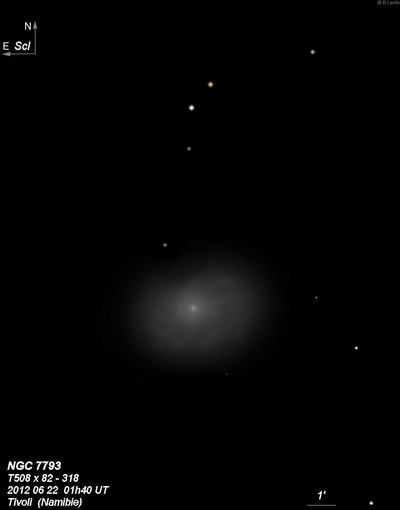
16x80mm (8/20/88): easily visible in the finder.
James Dunlop discovered NGC 7793 = D 608 = HN 4 on 14 Jul 1826 and recorded a "faint round nebula, about 2' diameter, with a very slight condensation towards the centre; a double star is north preceding" (2 observations). His position is 14' too far east (typical error). Apparently John Herschel didn't observe this galaxy from South Africa.
George Bond independently found the galaxy on 7 Nov 1850 at Harvard College Observatory with a 4" comet-seeker and announced it as a new discovery. Bond is credited with the discovery in the NGC. His RA is 40 seconds too large though he mentioned his position required further confirmation. Since John Herschel didn't include NGC 7793 in the GC (possibly because of Bond's comment) but Dreyer added it to the GC Supplement (6233). An accurate position from the Cordoba D.M was stated in the IC 1 notes.
Based on a photograph taken with the 30" Reynolds reflector at the Helwan Observatory between 1912-14, Harold Knox-Shaw first identified this galaxy as an "open spiral, knotty and complex." A later plate revealed a "bright sharp stellar nucleus" and "very many knots and patches."
200/250mm - 8" (11/8/80): very large, oval, low surface brightness.
400/500mm - 17.5" (8/20/88): bright, very large, oval 3:2 WSW-ENE, very large broadly brighter halo, small bright core. A mag 12 star is off the north side 2.8' from center.
600/800mm - 30" (10/15/15 - OzSky): at 303x; most of the detail seen in the 48" was visible, but the HII regions were not as obvious. The galaxy extended roughly 8' x 5' WNW-ESE and contained a relatively large core region that gradually brightened towards the center. Although the halo appeared mottled and ragged, spiral structure was subtle. A very low contrast "arm" extends due west on the northwest side of the core and another "arm" appeared to extend east on the southeast side of the core. I noted 4 HII regions: the most obvious is [H69] 20, a faint, 10" knot near the south edge of the halo, ~1.5' from center. [H69] 3/5, a larger, very diffuse isolated patch, perhaps 20" in size, was seen on the northeast edge of the halo, 2.9' from center. Closer to the core I noted two very low contrast knots, both ~8" in diameter. [H69] 11 is 1.3' NE of center and [H69] 10 is 1.2' E of center.
900/1200mm - 48" (10/31/13): bright showpiece galaxy, very large, oval 3:2 E-W, ~7'x4.5', large bright core. Spiral structure was evident, though it was difficult to trace individual arms except for one better defined arm attached on the west side of the core. This arm sweeps towards the east on the south side of the core (~2' from center) and ends just east of center. The halo appeared lumpy with an irregular surface brightness and several HII knots/associations were visible. The brightest individual knot is [H69] #20 from Paul Hodge's 1969 paper "HII Regions in 20 Nearby Galaxies". This fairly faint, 10" knot was easily seen 1.5' S of center, near the south side of the halo. [H69] #27, a slightly smaller and fainter patch is near the west-northwest end of the halo (1.9' from center). On the west-southwest side of the halo were two additional close, faint knots, both ~8" in diameter; [H69] #32 situated 2.3' from center and [H69] #33 at 2.4' from center. Finally, [H69] #3/5 is a fairly faint, 15" patch near the northeast edge of the halo, 2.8' from center. A mag 12.5 star is just off the northern edge, 2.9' from center.
Notes by Steve Gottlieb